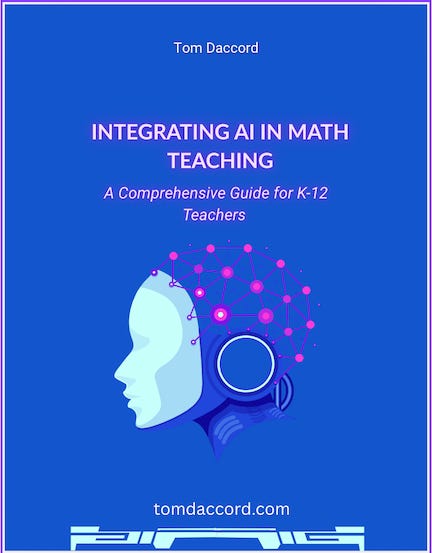Integrating AI in Math Teaching: A Comprehensive Guide for K-12 Teachers
My 90-page guidebook, free to download
I’m excited to announce the release of my latest guidebook, Integrating AI in Math Teaching: A Comprehensive Guide for K-12 Teachers. This 90-page resource is designed specifically for K–12 educators who want to better understand how AI can support effective, engaging, and supportive math instruction.
It is free to download at tomdaccord.com
This guidebook offers a clear and structured deep dive into AI’s math-related capabilities, including how popular models like GPT-4o perform across core domains like computation, reasoning, problem solving, and visual/spatial tasks. But the guide is far more than a summary of model capabilities. It presents a thoughtful and practical framework for approaching AI tools in the classroom, grounded in teaching challenges and opportunities. You’ll also find an extensive, categorized directory of AI tools for math instruction, complete with usage tips and key distinctions between tools like Khanmigo, MagicSchool, Wolfram Alpha, Desmos Studio, and more. In addition, you’ll also find a series of rich, classroom-based vignettes. These spotlight cases show how teachers across grade levels can integrate AI into their planning, scaffolding, conceptual instruction and formative feedback.
The guidebook stems from my concern that math teachers have received little guidance on implementing AI tools effectively in their classrooms. National studies reveal that most math teachers have never received AI training, lack an understanding of AI’s potential for math education, and (not uncoincidentally) are reluctant to use AI tools for instruction.
If you read The AI in Math Conundrum, you know I am struck by how much AI’s math abilities are misunderstood, with serious implications for commonly taught math subjects. Last year, I wrote about the potential to transform math instruction with AI in my book, AI Tools & Uses: A Practical Guide for Teachers. For that book, I researched numerous sources on AI in math instruction and interviewed K-12 math teachers, instructional technology specialists, and curriculum directors. Since the book’s publication, I have wanted to expand on my ideas for leveraging AI effectively for math instruction and also make this information freely available. So, this guidebook represents a much more detailed and expansive take on this subject than my book.
Integrating AI in Math Teaching: A Comprehensive Guide for K-12 Teachers is informed by my work over the last 25 years with hundreds of math teachers in districts, schools, and conferences. However, I am not a math teacher, so two individuals in particular helped me refine my ideas. For that, I am deeply grateful for the feedback and guidance provided by Karen Amy Levin, a veteran math teacher and the founder of Math for Humans. Karen’s critique and suggestions were invaluable. I’d also like to thank Fred Szabo, retired Professor of Mathematics and Statistics at Concordia University, for carefully reviewing the guidebook and for his encouragement.
AI also collaborated on shaping this guidebook. I used ChatGPT to brainstorm structures, refine language, and bring classroom scenarios to life. While the framework, insights and organization reflect my experience as a longtime edtech trainer, this emerging partnership greatly enriched the process. As a result, I believe the final product is stronger, more imaginative, and more useful.
Finally, whether you're cautiously curious or already experimenting, this guide offers clear direction and actionable insight. My hope is that it empowers teachers to lead the conversation on AI in math, not as passive adopters, but as critical thinkers and creative practitioners.


